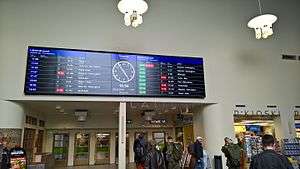Tampere Central Station
Tampere Central Station is a functionalist building in Tampere, Finland, designed by Eero Seppälä and Otto Flodin, completed in 1936. The 36-metre clock tower was later added because the Finnish railway bureau required it (its total height from ground level is about 50 metres). The city's main street Hämeenkatu begins at the railway station, continuing over the Hämeensilta bridge to its western end at the Aleksanteri church. The Itsenäisyydenkatu (originally called Puolimatkankatu) street begins at the Tammela side of the station, continuing to the Kaleva Church.

Tampere Tammerfors | |||||||||||||||||||||||||||||||||
|---|---|---|---|---|---|---|---|---|---|---|---|---|---|---|---|---|---|---|---|---|---|---|---|---|---|---|---|---|---|---|---|---|---|
| VR station | |||||||||||||||||||||||||||||||||
 Tampere railway station, July 2013. | |||||||||||||||||||||||||||||||||
| Location | Rautatienkatu 25, 33100 Tampere | ||||||||||||||||||||||||||||||||
| Coordinates | 61°29′54.5″N 023°46′23″E | ||||||||||||||||||||||||||||||||
| Owned by | Finnish Transport Agency | ||||||||||||||||||||||||||||||||
| Tracks | 5 | ||||||||||||||||||||||||||||||||
| History | |||||||||||||||||||||||||||||||||
| Opened | 1876 | ||||||||||||||||||||||||||||||||
| Traffic | |||||||||||||||||||||||||||||||||
| Passengers | 5.25 million (2018) [1] | ||||||||||||||||||||||||||||||||
| Services | |||||||||||||||||||||||||||||||||
| |||||||||||||||||||||||||||||||||
Situated in a central location, the station and its railway yard have served as divisors of the city's districts almost in the same way as Tammerkoski: Tamperean places are often located by saying which side of the station they are on.
For decades, there has been discussion of a unified travel centre in Tampere: currently, the long-distance bus terminal is quite far away from the railway station.
There are currently three platforms in the Tampere railway station, two of which have a roof. There are five tracks in total, but there are plans to add a fourth platform, making seven tracks in total.
About 80 trains arrive at and depart from the Tampere railway station every day, with 5.25 million passengers using the station in 2018. Most of the traffic is towards Helsinki. Tampere also has railway connections northwards, and towards the cities of Turku, Jyväskylä, and Pori. Pendolino trains go from Tampere to Helsinki, Kuopio via Jyväskylä, and Oulu via Seinäjoki.
The Tampere cargo station is located south from the passenger station. It includes one of the busiest railway organisation yards in Finland. The green building on the east side of the tracks, opposite the old passenger station is the old cargo station. A track leads from the cargo station, over the highway to Helsinki, to the Nekala district, which previously contained many private tracks servicing stock companies. Nowadays, some of the tracks have been disassembled and some are disused. The starting point of the track is used to store train carriages.
History
The first, wooden station building, predating the current station, was built in 1876 to service traffic in the recently completed track Turku-Tampere-Hämeenlinna. The old station was built into a 2nd class station according to specific plans contradicting the overall track design. Its designer is thought to have been Knut Nylander.
The station served its task well in its early days, because only a couple of trains arrived in Tampere per day. However, it soon became crowded, and the station had to be expanded several times. At that time, it was decided to build a new station in Tampere, and a design competition was held.
Connections between Tammela and the city centre were greatly improved when a tunnel was built underneath the station yard, completed at the same time as the new station.
Only very few changes have been made to the Tampere railway station over the years. In contrast, the area around the station has changed. In 1983, a shopping and parking building was built on the south side of the station. In 1989, a 98-metre shopping tunnel, known as Asematunneli (station tunnel) was built throughout the station building, containing about twenty shops. At the same time, the station's ticket office moved to its new premises. A new storage area for luggage was built next to the ticket office in 1994.
The tracks were greatly renewed in the late 1990s, and the loading tracks of the old cargo station were disassembled and the locomotive garage houses were disused. Many tracks leading to nearby storage buildings were also disassembled. In 2004, the track from the track yard to the Naistenlahti power station was cut from its northern end. The southern end is used to store and organise train carriages.
References
- "State rail monopoly VR to run Tampere trams from 2021". YLE. 25 April 2019. Retrieved 25 April 2019.
External links
| Wikimedia Commons has media related to Tampere railway station. |